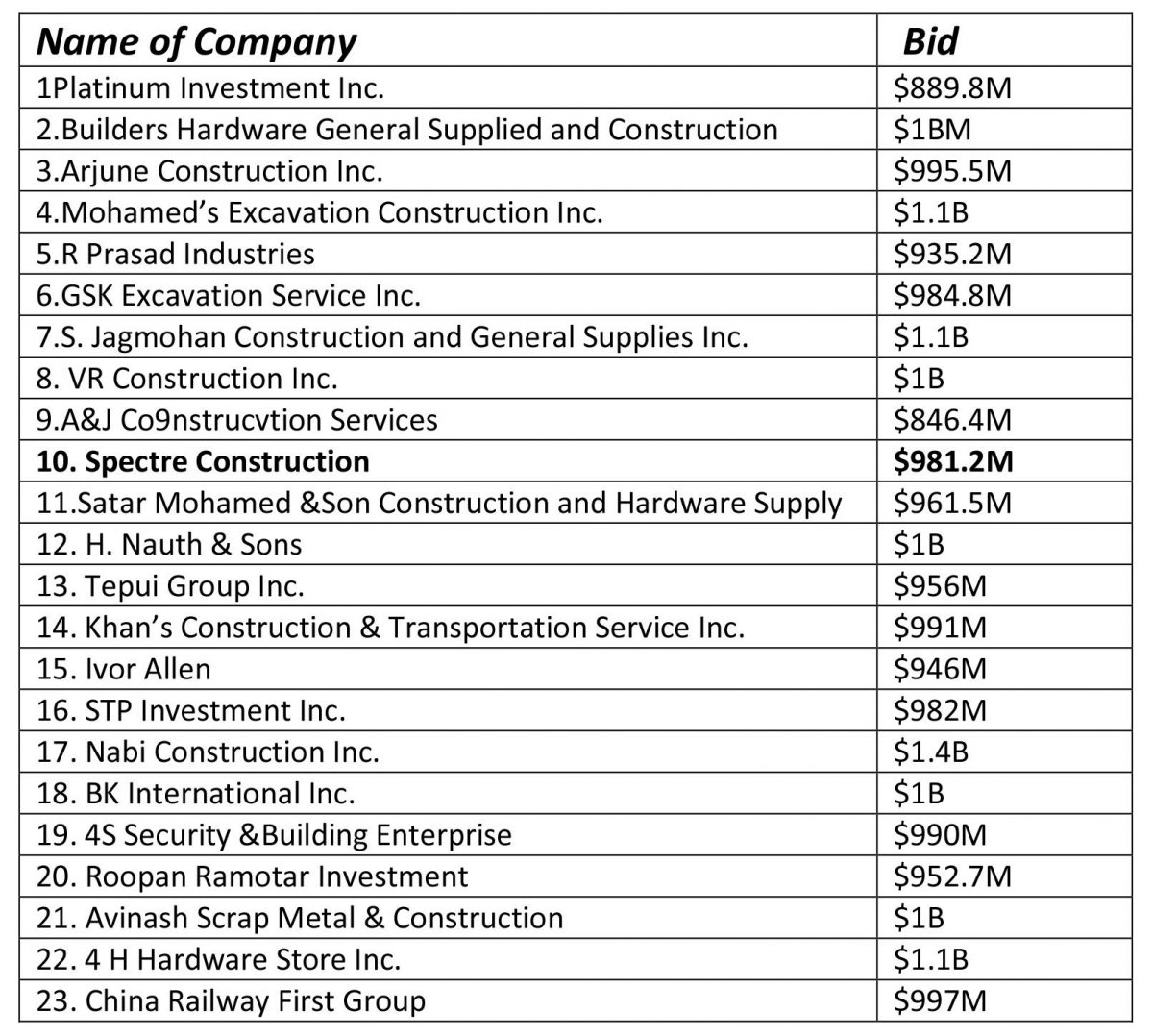Unlike the controversial bundling of three of four pump station contract awards to one project which it still cannot explain, the National Procurement and Tender Administration Board (NPTAB) records shows that the fourth project, erection of the Pouderoyen pump station, was awarded to Spectre Construction Inc.
“Please be advised that approval has been given for the contract Construction of Pump Station at Pouderoyen Region No. 3 to be awarded to…Spectre Construction for the sum of $981.201,750,” a letter from the NPTAB states.
On its website, the agency also states that the contract, with ID number 165/2023/21 was awarded to Spectre Construction.
With the Ministry of Agriculture’s National Drainage and Authority (NDIA) being the procuring entity, bids for the project were opened on June 27 of this year and it received twenty-three (23) tenders.
Three separate contracts for constructing water pump stations in Region Three were also opened.
The table below shows the names of the companies that bid for the Pouderoyen project along with the respective amounts.
The winning company – Spectre – has had much smaller government contracts awarded before and these include the construction last year of a sidewalk for the University of Guyana. That project had been on the agenda for many years and had been sought by students of the University of Guyana and the Cyril Potter College of Education.
With the Ministry of Local Government being the procuring entity, Spectre also won a contract last year June, to construct a two-storey building within Eccles Health Centre and that project was pegged at $31.4 million.
The contentious issue of pump station contract awards across the country is currently engaging the attention of the Public Procurement Commission and was raised when the $865 million Belle Vue agreement was made to the Tepui Group to build one at Belle Vue. This was because the company did not have the required experience, among other issues.
The matter was highlighted by Opposition Member of Parliament David Patterson and followed up by his fellow parliamentarian Ganesh Mahipaul. (See other story on page 10.)
In response to a public advertisement last May for the construction of the sluice and pump station at Belle Vue, there were 26 bids. The highest bidder was Nabi Construction Inc. with a bid price of $1,181, 867,183 while the lowest bidder was Gavco Construction & Supplies Inc. with a bid price of $740,584,800. Tepui Group’s bid was $865,543,500. Seventeen other bidders had bid prices lower than that of Tepui. The Engineer’s Estimate was $779,198,584.
Included in the advertisement were requests for the submission of bids for three other pump stations at Meten-Meer-Zorg and Pouderoyen in Region Three, and Jimbo at Gove, East Bank Demerara. These attracted 27, 23, and 29 bids, respectively, while the Engineer’s Estimates were $918,231,386; $945,179,772; and $865,182,752.
Following Patterson’s disclosure of the letter to the PPC, NPTAB issued a statement defending the award, contending that: (i) 13 of the 26 bids were deemed non-responsive and were therefore not considered; (ii) the lowest and second lowest responsive bidders were awarded the contracts for the construction of the pump stations at Meten-Meer-Zorg and Jimbo, respectively; and (iii) Tepui was the third lowest responsive bidder and was awarded the contract for the construction of the pump station at Belle Vue.
Former Auditor General Anand Goolsarran pointed out that there was, however, no mention of the Pouderoyen pump station, and “it would be of interest to learn who was awarded the contract and the basis for doing so.”
“Was it awarded to the fourth lowest responsive bidder from the tenders received in relation to the Belle Vue pump station?” he questioned.
The former Auditor General referred to the laws of this country, as he highlighted the process that should have been undertaken.
“Section 39(4)(c) of the Procurement Act provides for the Evaluation Committee to consider a tender as responsive only if it conforms to the requirements set forth in the tender documents. Minor deviations do not affect the responsiveness of the tender if they do not materially alter or depart from the characteristics, terms, conditions and other requirements set forth in the solicitation documents or if the tender contains errors or over sights that are capable of being corrected without touching on the substance of the tender. It would therefore also be of interest to learn who the 13 bidders are, and the grounds for the Committee’s assessment that their bids were non-responsive,” he noted.
“That apart, there is a distinction between lowest responsive bid and lowest evaluated bid. The lowest responsive bid is the lowest bid after setting aside bids that are not considered responsive, having regard to the requirements set forth in the bidding documents. On the other hand, by Section 39(2), in the evaluation of all tenders, the Evaluation Committee is required to use only the evaluation criteria outlined in the tender documents to determine which tenderer has submitted the lowest evaluated tender. Section 39(6) (a) also requires all evaluation criteria in addition to price to be quantified in monetary terms. The contract is to be awarded to the lowest evaluated tenderer,” he explained.






